Who is failing to acknowledge reality?
Many auto enthusiasts dislike crossovers because, taller and heavier than cars, they inherently handle with less agility. Yet an increasing number of high-performance crossovers have been finding buyers. Do the laws of physics force a choice between utility and driving enjoyment? Or can high-performance crossover owners really "have it all," with minimal compromises?
For agile handling, less (size and mass) is more. So the recent introduction of ultra-high-performance compact crossovers, with 400-plus horsepower, curb weights in the mid 4000s, and all of the space most people need (hence surging sales of the Honda CR-V and Toyota RAV4), provides the best chance yet of a "no compromise" vehicle.
The 400-horsepower 2015 Porsche Macan Turbo was the first. But the Alfa Romeo Stelvio Quadrifoglio, introduced as a 2018 model, could be the best. Ferrari helped wring 505 horsepower from a turbocharged 2.9-liter V6 engine. Unlike in the related Giulia QF sedan, an all-wheel-drive system helps convert all of this power into acceleration rather than rubber dust. Like in the Giuia QF, a twin-clutch differential actively distributes torque between the rear wheels to mitigate understeer and adaptive dampers seek to sharpen handling without killing the ride. So the Stelvio QF just might do justice to its namesake, a famed road that switchbacks over the Italian Alps.
BMW, Mercedes-AMG, and Jaguar also offer ultra-high-performance compact crossovers. Like the Alfa, the X3 M has a six-cylinder engine. The other two employ V8s, with the supercharged 5.0-liter engine in the F-Type SVR churning out a class-topping 550 horsepower.
With a focus on handling, I opted to compare the Stelvio to the Porsche. For 2019, the updated Macan topped out with the S (no updated Turbo until 2020). But 348 horsepower should be plenty for suburban roads, right?
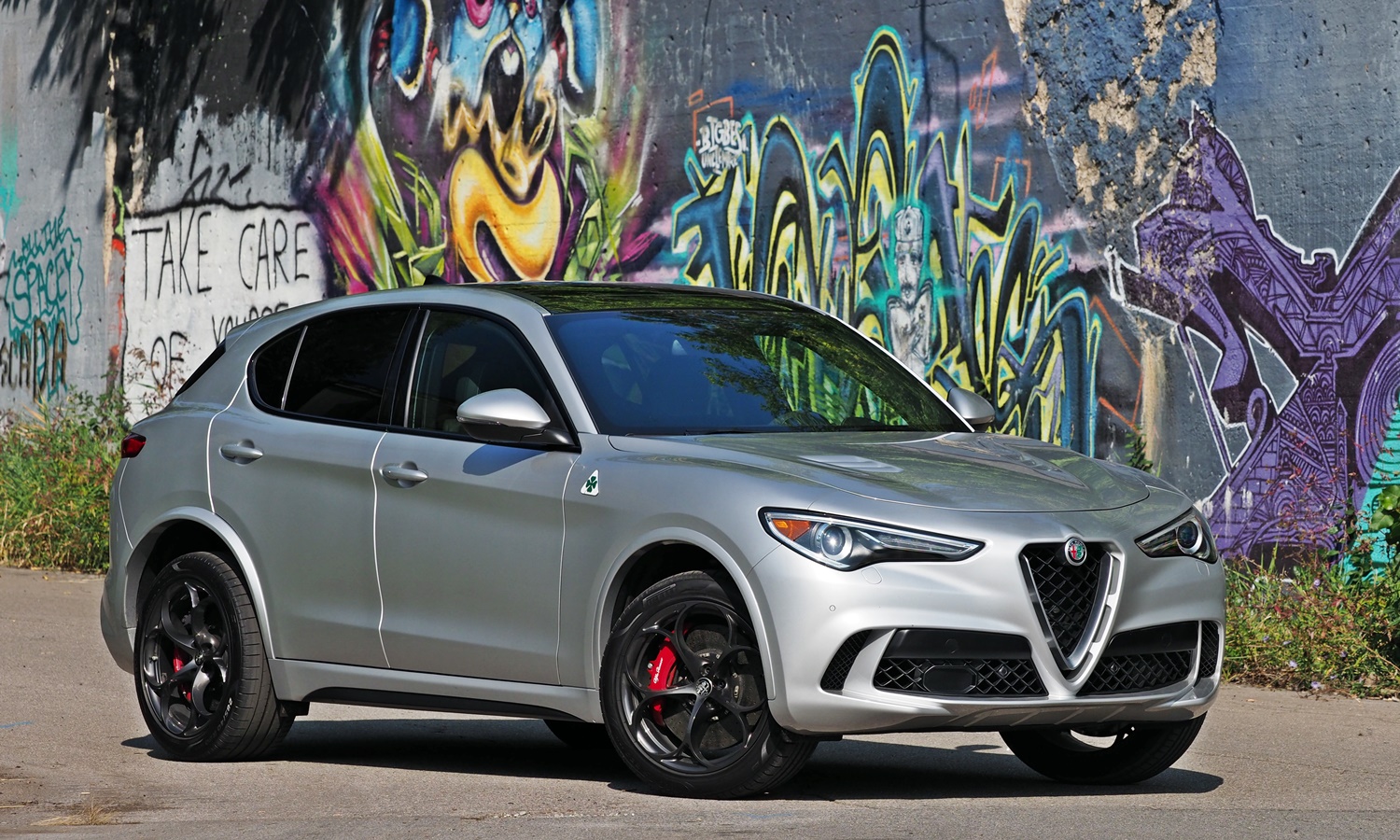
Aside from the Alfa face, we've seen this basic shape on many competitors beginning with the Audi Q more Stelvio photos
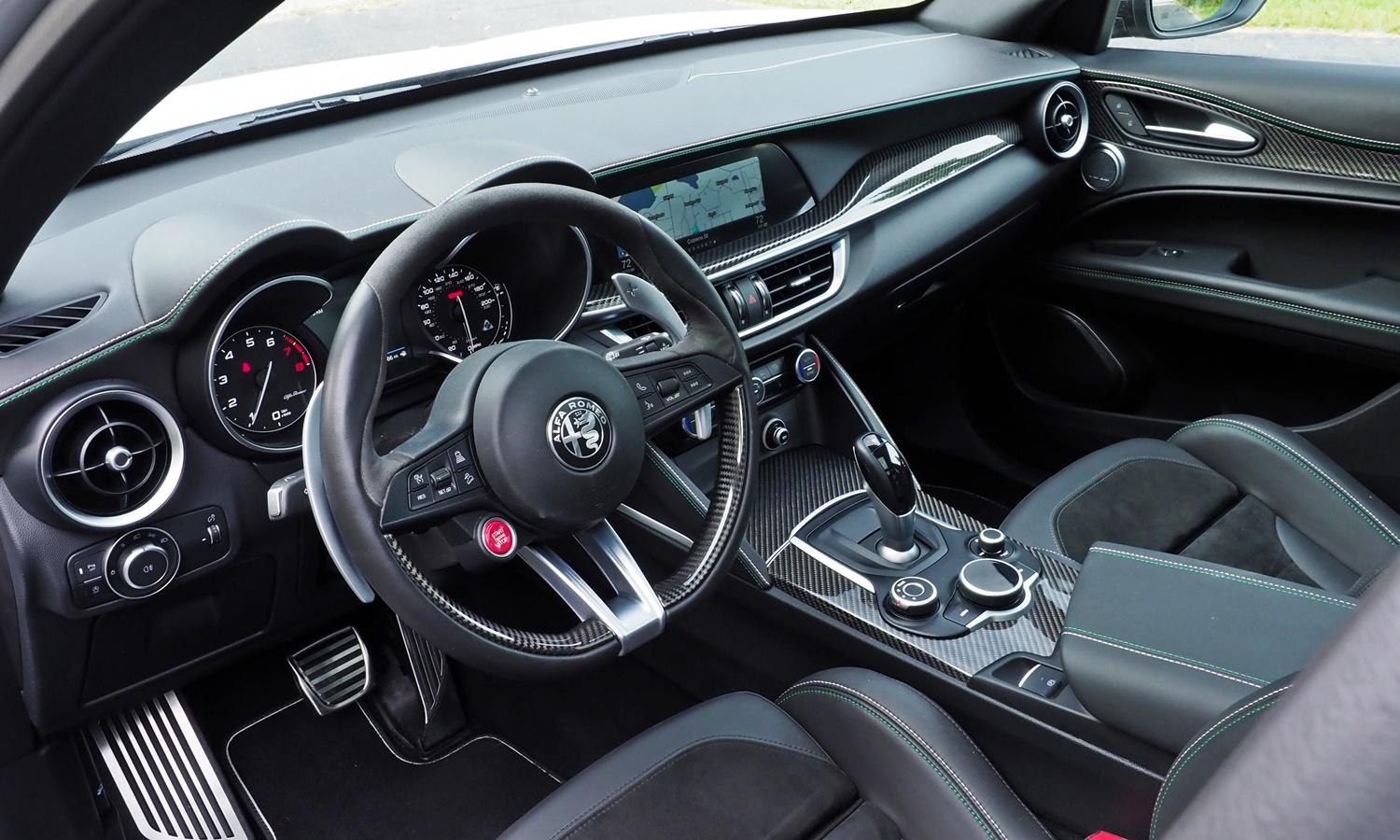
Leather, suede, and carbon fiber cover many surfaces. The other bits, though, don't measure up.
| |
Compared to the Macan |
| Handling |
 Better
Worse
Better
Worse
|
Most cars steer enough alike that I sometimes forget alternatives exist. The best of these steer with smooth precision and weighting that just feels right (and so does not call attention to itself). Point the car where you want it to go, and it goes there. The Porsche Macan S steers this way.
The Alfa Stelvio Quadrifoglio steers like something else. Its steering not only reacts far more quickly, but has an edge to it that makes even the smallest alteration in the wheel's angle feel like its immediately and directly affecting the angle and grip of the front tires. In the Porsche, in contrast, the process feels more gradual, with smooth rather than sharp transitions and less sense of a direct connection.
The chassis compare similarly. The Macan's suspension is technically excellent, handling very well without calling attention to itself. The Stelvio can be trickier thanks to an all-wheel-drive system that shunts power to the front wheels only when the rear ones slip and and that actively varies the torque split between the rear wheels, but by the same token has a broader range of reactions to driver inputs and generally feels much more alive. The tested Macan was not fitted with the optional ($1,500) torque vectoring system, which brakes the inside rear wheel in turns to counteract understeer. This might explain why it didn't feel nearly as willing to rotate and steadily (if slightly) understeered through curves. In contrast, the Stelvio QF readily oversteers when accelerating through a curve, and generally has the dynamic character of a rear-wheel-drive car.
Not that all is perfect with the Stelvio QF's handling. Although the Stelvio QF weighs a couple hundred pounds less than its competitors, it's still 4,300 pounds and never feels light and agile. I never forgot its height and heft. In short, it doesn't fully replicate the experience of driving a lower sport sedan much less a sports car.
But if fun, engaging handling is the goal, the Stelvio QF delivers it. And if you don't need (or want to pay for) the 505-horsepower engine? Based on my experiences in the 280-horsepower Giulia sedan, an intelligently optioned four-cylinder Stelvio will also have unusually quick steering for a crossover and likely handles nearly as well as the QF.
| Powertrain performance |
 Better
Worse
Better
Worse
|
Though competitors from Mercedes and Jaguar have 4.0- and 5.0-liter V8 engines, respectively, the relatively small 2.9-liter V6 in the Alfa Romeo Stelvio Quadrifoglio is strong enough to somehow make it just as quick. In magazine testing (with various tricks to achieve the strongest launch) the Stelvio gets from a dead stop to 60 mph in just a bit over three seconds. Simply mash the accelerator, and a momentary lull as the turbos spool up precedes the thrilling blast to 60, yielding a time in the mid 4s. Both figures are about the same as the others. At highway speeds there's no lull. Need a burst of speed to execute a pass? You've got it.
In Sport and Track modes, the Stelvio QF's active exhaust unmuffles various popping and crackling noises. While these do make driving the crossover more exciting, I've heard better--from V8s. The V6 might pull as strongly as a V8, but it doesn't sound as sweet. That said, the Ferrari-tuned six does sound considerably better than nearly any other six and any four, including the turbocharged 2.0-liter in lesser Stelvios. Sadly, it's not possible to separately select the open exhaust. If you want to hear the engine, fuel economy must take a hit. In competitors the throttle, exhaust, transmission shift points, steering, and adaptive dampers can often be adjusted separately. In the Alfa they must be varied together by selecting one of four uncustomizable modes, with a partial exception. In Sport and Track modes the dampers can be set one notch softer. But you cannot separately select the exhaust mode or pair firm dampers with an economy-oriented drivetrain (which I often like to do in suburban driving).
I haven't driven the regular, 280-horsepower Stelvio. In magazine tests it's about two seconds slower to 60 than the QF. While this is a substantial difference, especially in percentage terms, it's still pretty quick. In fact, it's nearly as quick as the six-cylinder, 348-horsepower Macan S I'm comparing to the QF.
Which means...the acceleration of the Macan S doesn't really compare to that of the QF. Approaching my test drive of the Porsche, I wondered if the Alfa's extra 157 horsepower would really make a difference when driving on suburban roads. How much horsepower can you really use? Not nearly 505, I figured. And the QF's engine is actually a bit smaller than the Porsche's, so unless you really wring it out does it feel substantially stronger?
Yes, yes it does. The Stelvio Quadrifoglio's acceleration feels much stronger and is much more thrilling, even within the legal limit on public roads. There is the aforementioned lull when accelerating from a dead stop. After that, it pulls like a boosted V8.
There's such a large price and performance gap between the regular Stelvio and the Quadrifoglio that a merely high-performance variant like those offered by competitors seems a no-brainer. Yet one is not offered.
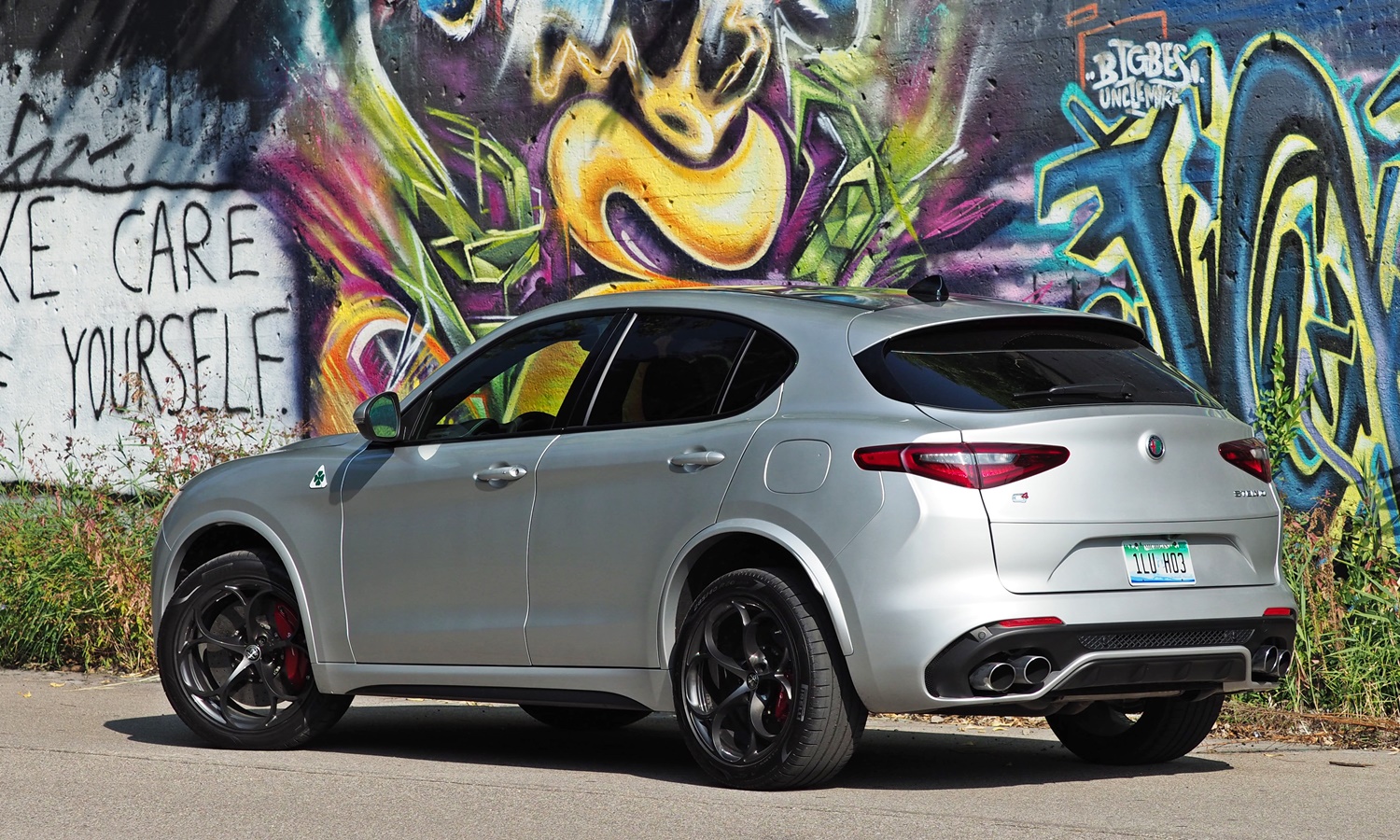
Unnecessary boomerang-shaped character line parallels cut line. Otherwise generic from this angle.
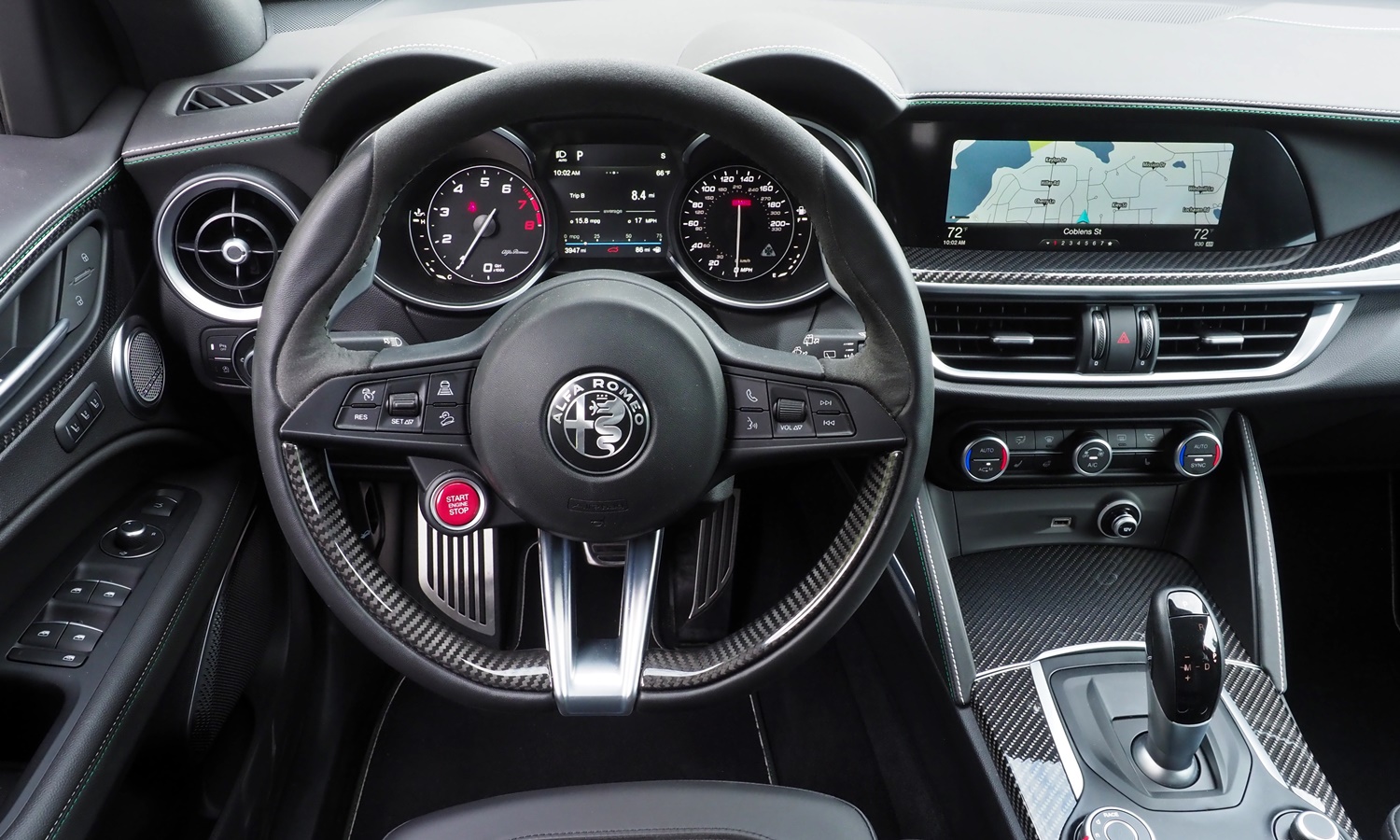
Sporty but dated cockpit. Many controls not intuitive. Smallish display.
| Ride smoothness |
 Better
Worse
Better
Worse
|
For a crossover that handles so well, I was surprised that even in Track mode with the dampers set to firm (the default) the Stelvio's ride is far from punishing. In the other modes, with the dampers set to soft, the ride is just a little smoother. The Macan S rides even more smoothly, perhaps as smoothly as any compact crossover I've driven, but this impresses less since the Porsche doesn't handle with the same verve as the Alfa.
| Fuel economy |
 Better
Worse
Better
Worse
|
For a 505-horsepower, 4,500-pound crossover, the Alfa Romeo Stelvio Quadrifoglio can get very good fuel economy. Driving with a light foot in "a" (Advanced Efficiency) mode, I observed trip computer averages in the mid-twenties in both suburban and highway driving. Note that I said "can." Drive the Stelvio QF like you stole it in "d" (Dynamic) mode and the average plunges into the low teens. Keeping pace with traffic in "n" (Natural) mode yielded mpg in the high teens or low twenties.
In the EPA's tests, the Stelvio QF scored 17 mpg city, 23 mpg highway. The Macan S, with 157 fewer horsepower, managed only a single mpg better in the city and the same on the highway.
Usually ultra-high-performance engines guzzle fuel. Trade-offs, you know. But Alfa Romeo has developed an ultra-high-performance engine that only uses extra fuel if you use its extra potential. I'm impressed.
| |
Compared to the Macan |
| Reliability & durability |
 Better
Worse
Better
Worse
|
TrueDelta has no reliability data on Alfa Romeos. Car magazines have often reported reliability issues--and they only had each vehicle for a week or two.
| Materials & workmanship |
 Better
Worse
Better
Worse
|
Inside the Alfa Romeo Stelvio Quadrifoglio, the instrument panel and upper doors as well as the seats are upholstered in leather, and the trim is carbon fiber. But too many of the other interior parts would be marginal in a $40,000 car, and are thus not nearly worthy of an $80,000 car. The HVAC controls could be from any Chrysler. Pulling the door shut I often felt some give in the handle and heard a slight creak. You're buying this high-end crossover for its powertrain and chassis, not for its interior.
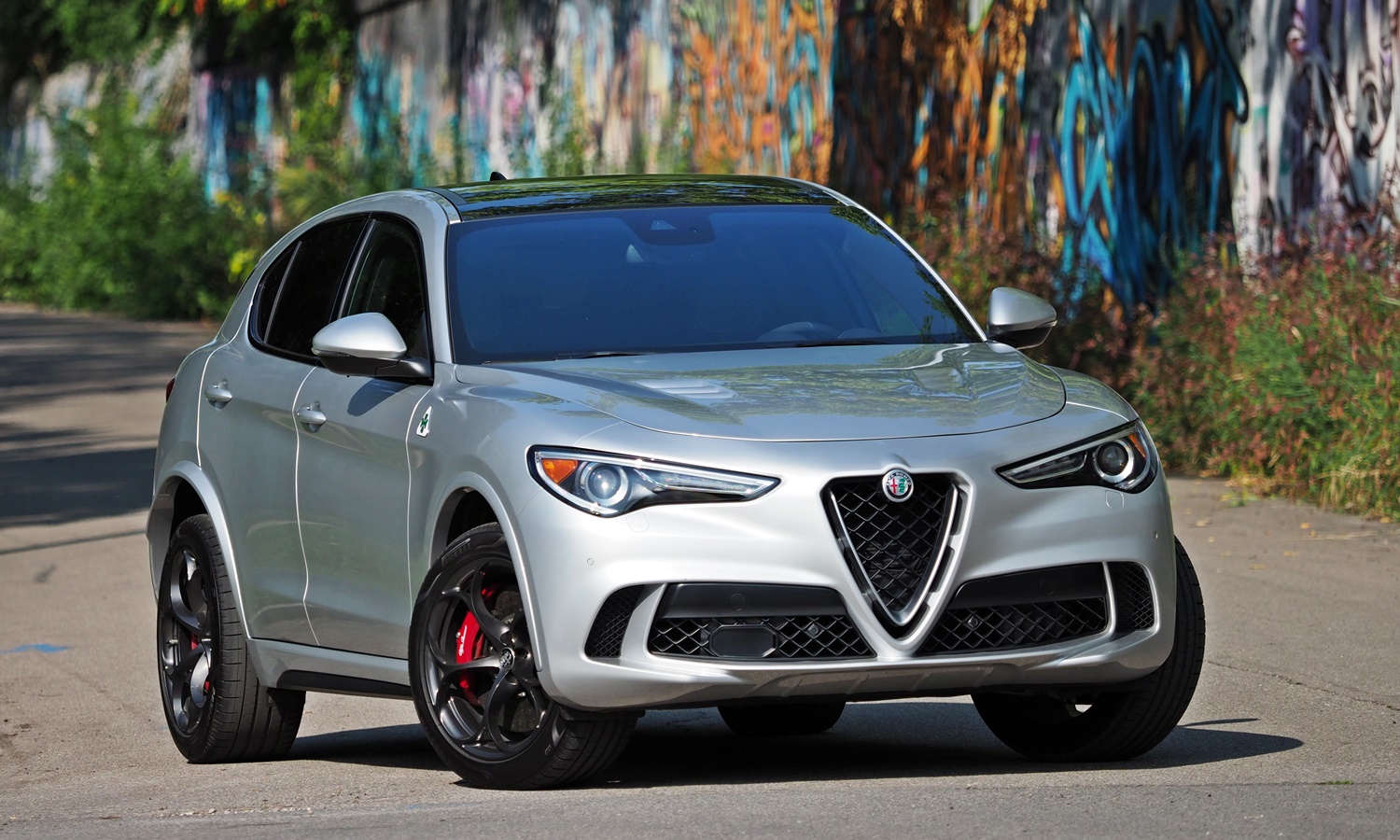
Does the traditional Alfa grille shape work on a taller crossover face? Thankfully no huge badge.
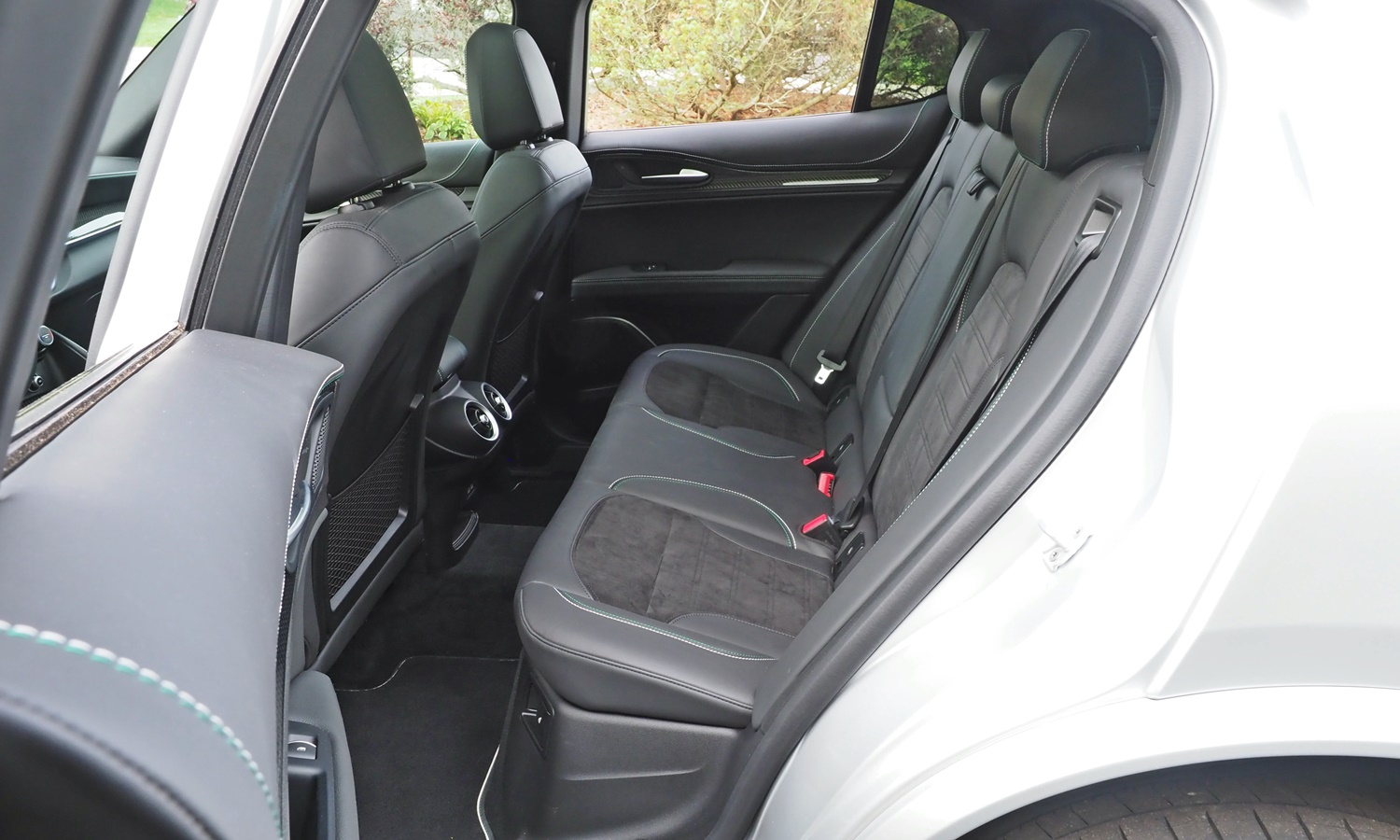
Comfortable height and sufficient room in rear seat. The Macan is a little tighter.
| Front seat support & comfort |
|
From the shoulders down the Alfa Romeo Stelvio Quadrifoglio has a comfortable and supportive front seat. The adjustable side bolsters provide much better lateral support than the much smaller bolsters on the standard Macan seats (Porsche does offer better-bolstered seats as options). Unfortunately, the Alfa's headrests are too far forward for drivers with upright postures (such as myself) and lack a fore-aft adjustment. The Porsche's seats include such an adjustment, as do most in this price range.
| Controls and instruments |
 Better
Worse
Better
Worse
|
The Stelvio's climate controls include simple, conventional knobs. The other controls tend to be less easy to understand and operate. The infotainment system, operated via a knob and pair of buttons on the console, is far from intuitive. Good luck learning how to learn all of its ins and outs without reading the manual. Even the turn signals proved relatively difficult to operate as the stalk is buried behind a large column-mounted shift-paddle. Often when seeking just three blinks to change lanes I got a full signal which then needed to be manually canceled.
The Macan's interior includes far more buttons. These make basic tasks more complicated--it's hard to best a small number of large knobs here--but they enable adjustments that you must either dig through menus to make in the Alfa or cannot make at all. The Macan's infotainment system, updated for 2019, includes a huge display and much more sophisticated graphics than the Stelvio's. It's easier to operate than the Alfa's, but this isn't to say it's easy. It's not.
| Driving position & visibility |
 Better
Worse
Better
Worse
|
The view forward from the Alfa Romeo Stelvio's driver seat could be more open, as its instrument panel is relatively tall. The rear seats block most of the view to the rear, reducing the space between them and the roof to a slot. I appreciated the blind spot warning system and rearview camera.
In the Porsche Macan a lower, more compact instrument panel makes for an airier cockpit and a more open view forward.
| |
Compared to the Macan |
| Rear seat room & comfort |
 Better
Worse
Better
Worse
|
The Stelvio's rear seat is mounted comfortably high off the floor--something that cannot be taken for granted in crossovers--and is a little roomier than the Porsche Macan's. Sitting behind my 5-9 self in the Alfa, I had about six inches between my knees and the front seat back and a couple of inches between my head and the headliner.
| Cargo capacity |
 Better
Worse
Better
Worse
|
The Stelvio's cargo area is usefully long, but narrower than most.
| Exterior styling |
 Better
Worse
Better
Worse
|
With vents in the hood, flares around the wheel openings, and muscular fenders, the the Alfa Romeo Stelvio Quadrifoglio's exterior successfully communicates its performance potential. But is it a beautiful vehicle? Take away the vents and flares and the Stelvio would look much like the many other Audi-influenced crossovers. The Porsche Macan, though it similarly resembles the Audi Q5 on which it is based, has cleaner lines and a sleeker shape.
The Stelvio's interior similarly communicates the vehicle's performance, but otherwise isn't especially artful. The infotainment system doesn't appear nearly as up-to-date as the Porsche's, which was revised for the 2019 model year.
| Safety & braking |
 Better
Worse
Better
Worse
|
Even without the tested crossover's carbon ceramic brake rotors, the Stelvio QF has large, powerful brakes. Unfortunately, these brakes are also touchy, requiring more attention than most to achieve a smooth stop in normal driving. It took me a couple of days to get used to them.
Automatic emergency braking is available, but unlike in an increasing number of competitors it is not standard. Lane departure warning is in the same optional package. As is usually the case, it's more nuisance than help. Lane keep assist is not offered.
| Price or payments |
 Better
Worse
Better
Worse
|
Ultra-high-performance compact crossovers are all priced close enough together that price is not likely to be a deciding factor.
The Alfa Romeo Stelvio Quadrifoglio starts at $81,590. A "driver assist package" that includes adaptive cruise control and lane departure warning adds $1,200. A panoramic sunroof adds another $1,350. Cosmetic options add a further $1,850. These are likely common options. Less common, and unneeded by the great majority of owners: $8,000 carbon ceramic brake rotors. The bottom line for the loaded test vehicle: $94,190.
The Porsche Macan S lists for much less, with a $59,850 base price and $74,770 as-tested. But the S, while the most powerful Macan for 2019, will be joined by the 434-horsepower Macan Turbo for 2020. The new Macan Turbo starts at $84,950 and lists for $100,450 when equipped like the tested Stelvio. And it still won't be as powerful.
Other competitors do not offer carbon ceramic brake rotors. Without these the tested Alfa would have listed for $86,190. No need for the black wheels and carbon fiber steering wheel trim? Then $85,290.
The 550-horsepower Jaguar F-Pace SVR has a base price close to the Alfa's, $80,985. Carbon ceramic brake rotors are not offered. Otherwise equipped like the tested Alfa the Jaguar lists for $84,590. The new-for-2020 473-horsepower BMW X3 M starts $10,000 lower than the others. Unless you need the upgraded 503-horsepower Competition variant. Then it starts in the same ballpark, $77,895. Adding a couple of packages to get features on the tested Alfa brings the bottom line to $84,045.
The 469-horsepower Mercedes-AMG GLC63 is priced like the "basic" X3 M with a base MSRP of $71,795. Equipping it like an $85,290 Alfa brings its price to $81,095. The cheapest of the bunch, but also the least powerful.
For more power in a compact Mercedes crossover you'll need the Coupe variant of the GLC in 503-horsepower 63 S form. The price then starts at $81,800 and ends up at $89,245. For carbon ceramic brake rotors--on only the front wheels--add another $5,450.
The prices for the Mercedes do include the top leather interior to hopefully match the hide coverage in the Alfa. The BMW's and Jaguar's instrument panels are upholstered in synthetic leather (i.e. vinyl).
Aside from leather coverage, though, the Alfa's feature list falls short. You cannot get ventilated front seats or heated rear seats. Nor can you get a head-up display, an around-view camera system, lane keep assist, internet connectivity, or a telematics system. In terms of available features, the Stelvio is falling well behind the upscale vehicle curve.
Also not available in the Stelvio, but similarly not available in any competitor: a manual transmission.
Compact crossover sales have been surging. For many makes they've already become the best-selling model. While you can buy a larger crossover, these offer all of the passenger and cargo space most people need. Since they're also lower and lighter than larger crossovers, they also tend to handle more like cars. This opens up the potential for a vehicle that "has it all," the utility and seating position people want plus the performance and handling enthusiasts crave. In response, ultra-high-performance crossovers recently have become a thing.
But do these deliver? The Alfa Romeo Stelvio Quadrifoglio doesn't handle quite like a sport sedan, but it is nonetheless a blast to drive thanks to a V6 that performs like a V8, quick steering, and a highly competent, engaging chassis. A Porsche Macan, while technically excellent, with a surprisingly good combination of precise handling and smooth ride for a crossover (or even a regular car), isn't nearly as exciting. Plus if you can somehow drive the Stelvio QF with economy in mind, it manages decent fuel economy, with no apparent penalty for its extra power compared to the much weaker Porsche. Sadly, other tradeoffs that have nothing to do with physics remain. No one seems to trust the current Alfa's to be reliable. Interior materials and available features also lag competitors.
Is the Stelvio Quadrifoglio so much fun that these tradeoffs seem justified? For committed driving enthusiasts (who nevertheless want a crossover), yes. It's truly a different animal. For the typical buyer of something German, probably not. Hopefully Alfa can fix the reliability issues and upgrade the interior rather than again giving up on the American market, as they really do offer a special something others do not. Add this special something to a crossover, and you've got the most exciting one I've driven.
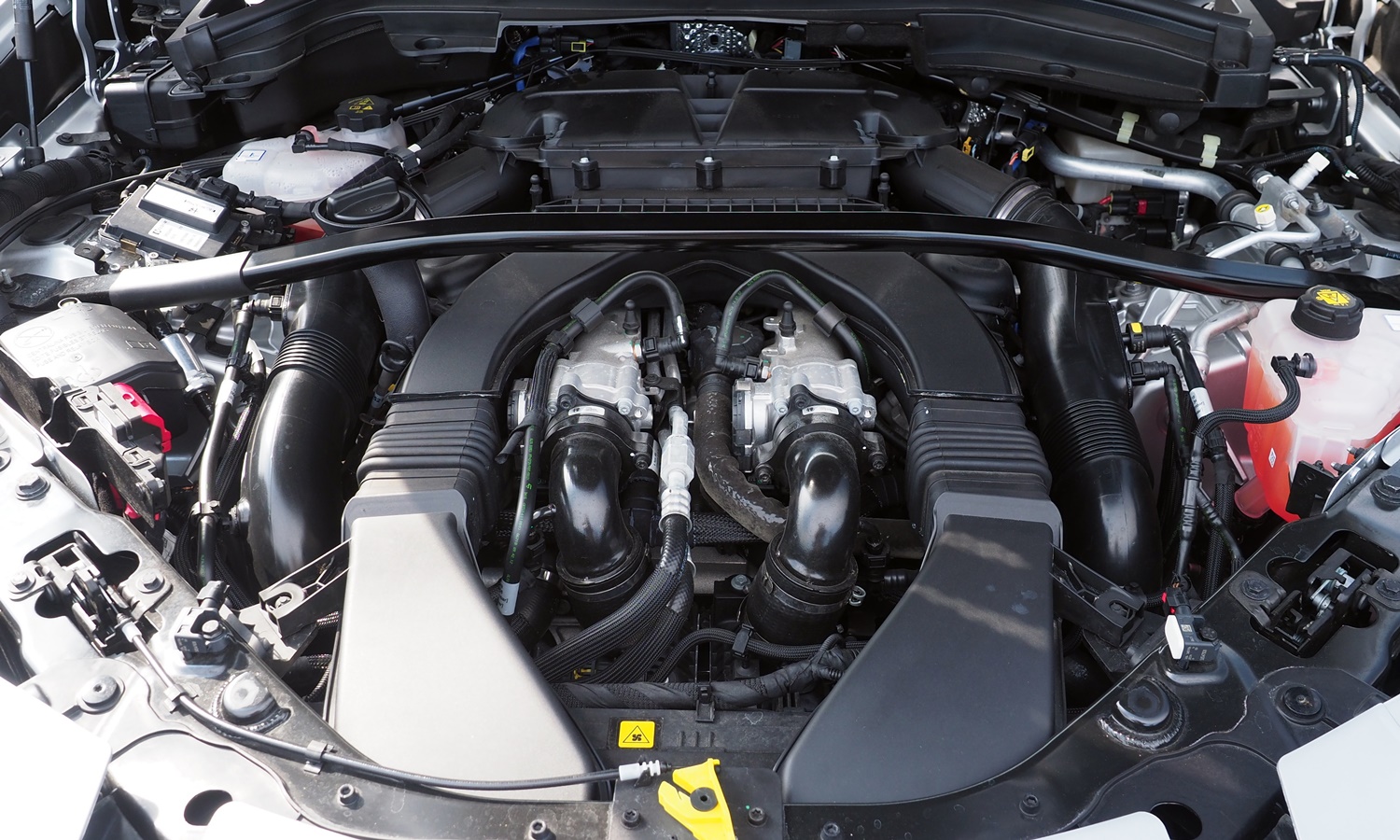
No cover, still can't see the engine. It takes a lot of plumbing to extract 505 hp from 2.9 liters
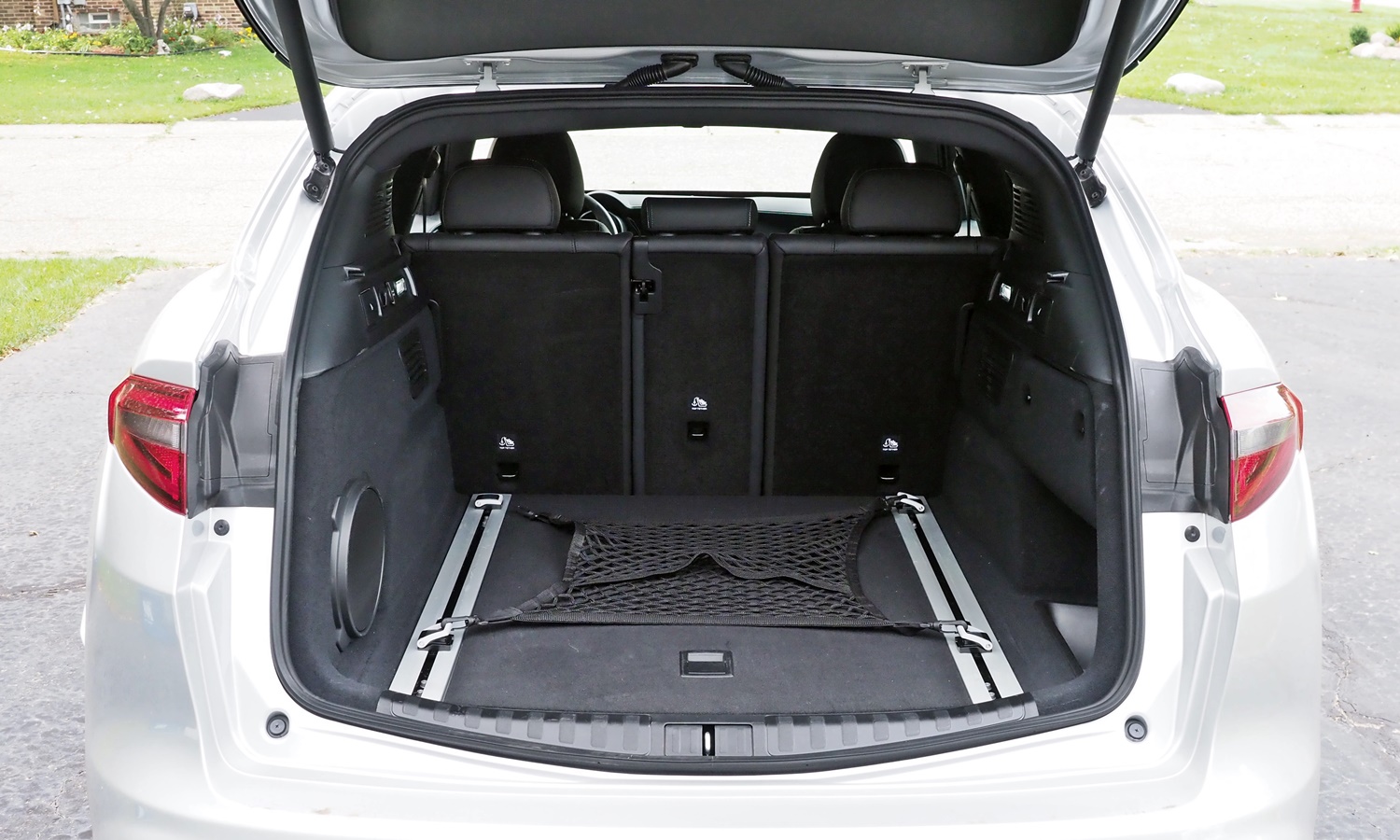
Narrow cargo area. Not much space between the seat backs and the ceiling.
See more 2019 Alfa Romeo Stelvio photos
Alfa Romero provided an insured car for a week with a tank of gas. Dan Kelley of Suburban Porsche in Farmington Hills, MI, provided a Macan S for comparison purposes. Dan can be reached at 248-741-7903











